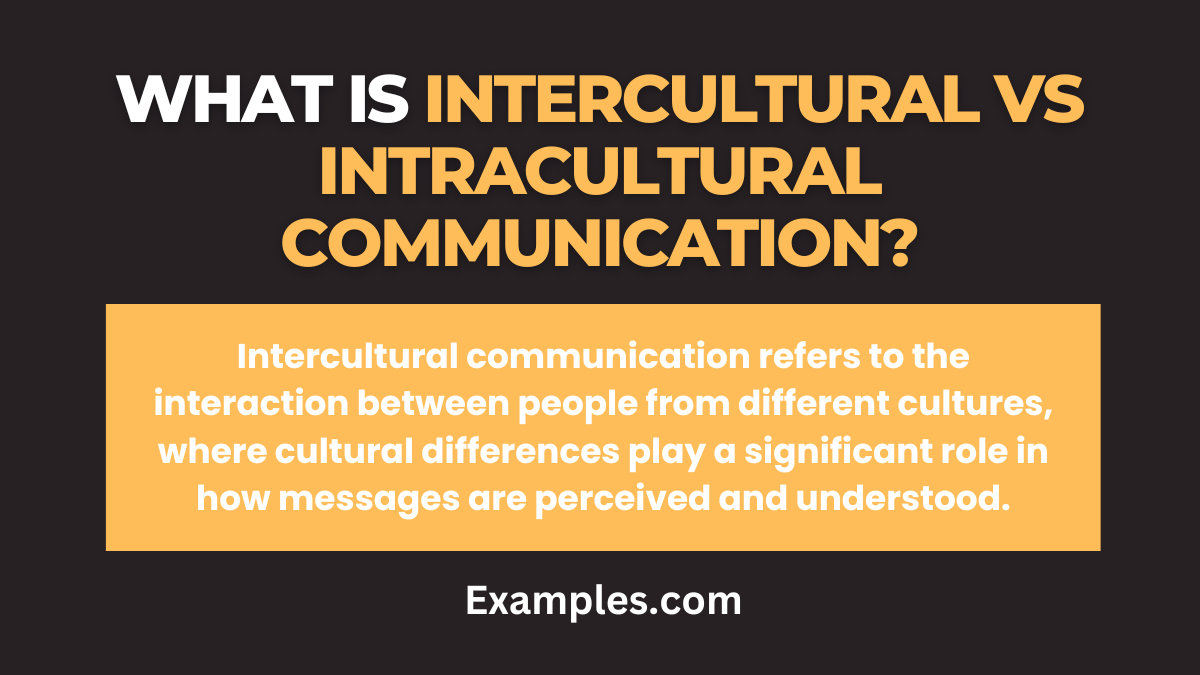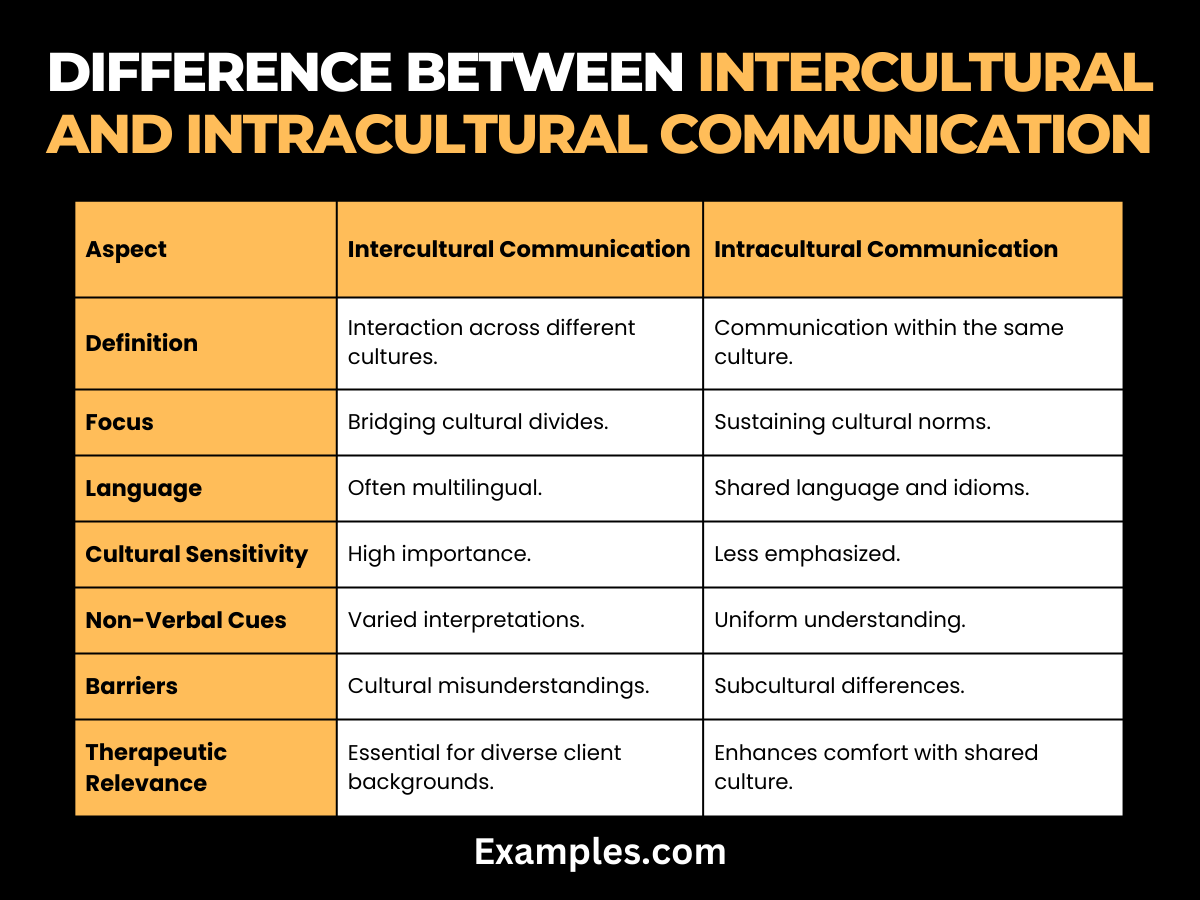Intercultural vs Intracultural Communication – 19+ Examples
Embark on a journey to understand the intricate dynamics of Intercultural vs Intracultural Communication with this detailed guide. Delve into the world of communication across and within cultures, exploring key distinctions and practical implications. This guide, enriched with Intercultural Communication Examples, offers insights into the nuances that differentiate these two forms of communication. Whether you’re a professional navigating global workplaces or a student in multicultural settings, this guide is an invaluable resource for enhancing your communication skills.
What is Intercultural vs Intracultural Communication?

Intercultural communication refers to the interaction between people from different cultures, where cultural differences play a significant role in how messages are perceived and understood. It involves recognizing and navigating cultural norms, values, and language differences. In contrast, intracultural communication occurs within the same culture, where people share similar cultural backgrounds and understandings. This type of communication often has less potential for misunderstanding as the participants generally have the same cultural references and norms. Both forms are essential in today’s globalized world, where understanding and effectively managing cultural differences can lead to more successful and meaningful interactions.
Difference Between Intercultural and Intracultural Communication
In exploring the nuances of communication, it is essential to understand the distinctions between intercultural and intracultural communication. Both forms play a pivotal role in fostering understanding and interaction in diverse settings, including therapeutic environments. Here, we present a comprehensive guide outlining these differences in a tabular format for clarity and ease of comprehension.

| Aspect | Intercultural Communication | Intracultural Communication |
|---|---|---|
| Definition | Involves interaction between individuals from different cultures, often encompassing varying languages, beliefs, and customs. | Occurs within the same cultural context, where individuals share similar cultural norms and language. |
| Primary Focus | To bridge the cultural divide and facilitate understanding across diverse cultural backgrounds. | To reinforce and sustain shared cultural values, norms, and language within a cultural group. |
| Language Use | May involve multilingual communication, requiring translation or interpretation. | Primarily uses a shared language, with nuances and idioms understood by all parties. |
| Cultural Awareness | High level of cultural sensitivity and awareness is crucial to avoid misunderstandings. | Less emphasis on cultural sensitivity, as shared cultural understanding is assumed. |
| Non-Verbal Cues | Non-verbal communication can vary significantly and is often interpreted differently across cultures. | Non-verbal cues are generally understood in a uniform manner within the same culture. |
| Barriers | Language barriers, cultural misunderstandings, and stereotyping can impede effective communication. | Misunderstandings may arise from regional dialects or subcultural differences but are generally less pronounced. |
| Examples | A conversation between a therapist from the United States and a client from Japan. | A discussion between a therapist and a client who both grew up in rural Texas. |
| Relevance in Therapeutic Settings | Essential for therapists working with clients from diverse backgrounds, promoting empathy and understanding. | Important for therapists to connect with clients on a shared cultural level, enhancing comfort and trust. |
| Skill Set Required | Requires intercultural competency, the ability to navigate and respect cultural differences. | Requires an in-depth understanding of specific cultural norms and values of the group. |
10 Examples of Intercultural Communication
Intercultural communication plays a crucial role in today’s globalized environment. It involves interactions where cultural diversity influences the exchange of information. Here are 10 examples, highlighting the complexity and richness of intercultural communication:
- Language Translation in Business Meetings: In multinational companies, translating languages during meetings to accommodate different nationalities is a common practice.
- Cultural Sensitivity Training for Employees: Companies often conduct training to help employees understand and respect different cultural norms and practices.
- International Marketing Campaigns: Adapting marketing strategies to suit diverse cultural preferences and taboos in different countries.
- Cross-Cultural Negotiations: Business negotiations involving parties from different cultures, requiring an understanding of diverse negotiation styles and etiquette.
- Exchange Student Programs: Students studying abroad and adapting to new educational and cultural environments.
- Diplomatic Relations Between Countries: Diplomats engaging in dialogue while respecting and acknowledging different cultural backgrounds and political systems.
- Intercultural Marriage Counseling: Counselors addressing marital issues between partners from different cultural backgrounds.
- Healthcare Providers Working with Diverse Patient Populations: Medical professionals tailoring their communication and treatment approaches to respect patients’ cultural beliefs.
- Tour Guides with International Tourists: Guides explaining local customs and traditions to tourists from various cultural backgrounds.
- International Film Production Teams: Collaborating on film projects, bringing together diverse cultural perspectives and working methods.
10 Examples of Intracultural Communication
Intracultural communication involves interactions where individuals share the same cultural background, leading to a more intuitive understanding and shared context. Here are 10 examples of intracultural communication, highlighting its role in fostering connection and understanding within a single culture:
- Community Gatherings and Celebrations: Local festivals or community events where people celebrate shared cultural traditions and values.
- Workplace Communication in a Local Business: Employees in a local company discussing projects and tasks using shared cultural references and jargon.
- Family Discussions and Decision-Making: Conversations within families that are influenced by shared cultural values, beliefs, and experiences.
- Local Political Campaigns: Politicians addressing the public in a specific cultural context, using culturally relevant symbols and language.
- Education in Local Schools: Teachers and students interacting within the framework of the local education system and cultural norms.
- Neighborhood Meetings: Residents discussing community issues and making decisions based on shared local experiences and understandings.
- Religious Services and Activities: People participating in religious practices and discussions that are specific to their shared cultural or spiritual beliefs.
- Local Media and News Outlets: Media communicating news and stories that resonate with the local population’s cultural context and experiences.
- Retail and Customer Service within a Community: Interaction between customers and service providers that reflects local customs, language, and etiquette.
- Cultural Art and Music Events: Local artists and musicians performing and engaging with an audience that shares a common cultural heritage and appreciation.
Comparison Between Intercultural and Intracultural Communication
While intercultural and intracultural communication are distinct in many ways, they also share some similarities, especially when analyzed in the context of enhancing communication skills and understanding in diverse environments. These similarities are crucial in the field of Intercultural Communication, where the focus is not only on the differences but also on the commonalities that can bring people together.
- Focus on Effective Communication: Both intercultural and intracultural communication aim to convey messages clearly and effectively, ensuring mutual understanding.
- Contextual Importance: Context is a key element in both types, where understanding the situational or cultural background is vital for accurate communication.
- Use of Verbal and Non-Verbal Elements: In both forms, a mix of verbal language and non-verbal cues like body language and facial expressions are used to convey messages.
- Potential for Misunderstandings: Miscommunications can arise in both intercultural and intracultural settings, necessitating careful interpretation and clarification.
- Adaptability and Flexibility: Effective communicators in both realms are adaptable and flexible, adjusting their communication style as per the situation or audience.
- Influence of Personal and Cultural Identity: Individual identities and cultural backgrounds significantly influence how messages are conveyed and interpreted in both types of communication.
- Role in Building Relationships: Both types of communication are fundamental in building and maintaining personal and professional relationships.
- Requirement for Cultural Awareness: Whether communicating across cultures or within one’s own, being aware of cultural norms and values is important for respectful and effective communication.
Relationship Between Intercultural and Intracultural Communication
The relationship between intercultural and intracultural communication is intricate and vital in understanding how people from different and similar cultural backgrounds interact and convey information. This comprehensive guide explores the dynamics between these two forms of communication, emphasizing their importance in the realm of Intercultural Communication.
The Influence of Culture on Communication
Culture profoundly influences how people communicate. In intracultural communication, shared cultural norms and values facilitate a mutual understanding, often making communication more straightforward. For example, in Intercultural Communication in the Workplace, employees from the same cultural background may effortlessly understand colloquialisms and non-verbal cues.
Conversely, intercultural communication involves bridging diverse cultural perspectives, which can be challenging but enriching. It requires an understanding of different cultural norms, beliefs, and communication styles, often necessitating more explicit and careful conveyance of messages.
The Role of Cultural Awareness
Cultural awareness is pivotal in both intercultural and intracultural communication. In the context of intercultural communication, awareness leads to better adaptation and understanding of diverse communication styles, as seen in scenarios like Cross Cultural Communication. On the other hand, in intracultural communication, cultural awareness helps in recognizing and respecting subcultural differences within the same larger culture, thereby avoiding assumptions and stereotypes.
The Intersection and Interplay
The intersection of intercultural and intracultural communication is most evident in multicultural societies where people from various cultural backgrounds coexist. In such contexts, individuals often switch between intercultural and intracultural modes of communication, depending on their audience. This flexibility enhances Intercultural Communication Competency, allowing for more effective and inclusive interactions.
In summary, the relationship between intercultural and intracultural communication is complex yet complementary. Both forms require an understanding and appreciation of cultural nuances to facilitate effective communication. Mastering both intercultural and intracultural communication is essential for anyone looking to navigate today’s increasingly interconnected world successfully.



